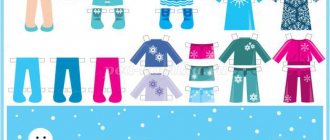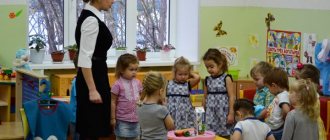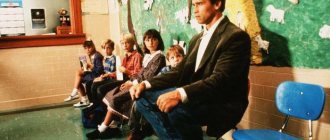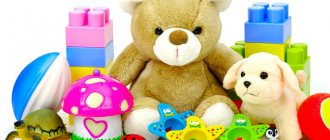Shoes and hats. Lesson in the younger group
Approximate Basic Educational Program Age group: junior Theme of the educational activity “Shoes and hats” Direction of development – cognitive, speech, artistic and aesthetic. Goal: to create conditions for the formation of general concepts of hats and shoes. Tasks:
- contribute to the accumulation of ideas about hats and shoes.
- To develop the ability to find them in the surrounding (specially created) environment.
- Cultivate a neat, caring attitude towards shoes and hats.
Types of activities: gaming, communicative, motor, visual (drawing), musical. Forms of organization – group. Forms of implementation of children's activities:
- Speech outdoor game “Boots”
- Solving a problem situation
- Painting a boot
Equipment Demonstration - pictures of hats, Panama hats, scarves, baseball caps, felt boots, rubber boots, shoes. Handout – boot template, colored pencils. GCD move
— Guys, do you like to solve riddles? - Yes. Today I will tell you a few riddles, and you try to guess them.
- And in the frost and in the cold
She will always save you, So that your health is not shaky. Put... (a hat) on your head.
- Put it on my head
And run on the hottest day, And if you take it off, mom is unhappy, I am a summer hat (Panama hat).
- Warm, comfortable, keep your feet warm,
They allow you to walk through the snowdrifts for a long, long time (felt boots).
- If it rains we don't bother -
We splash around briskly through the puddles. The sun will begin to shine - We should stand under the coat rack (rubber boots).
-Well done boys! Guessed all the riddles. - Now look and tell me what you see in the pictures? (panama hat, scarf, hat, baseball cap). -What is this all called? — That's right, hats. -What do you see in these pictures? (boots, shoes, felt boots). -What is all this called? - Yes, these are shoes. - Guys, what are hats for? — Put it on your head to keep it warm or to prevent the sun from baking your head. -What are shoes for? - So that your feet don’t freeze, so that they are warm. So that your feet don't get wet. To avoid hurting your feet. - Guys, now take one picture at a time, and where the hat is, put the hats. And where the boot is - shoes. - Well done, everyone completed the task! - Now let’s stand in a circle and play the game “Boots.” You've dressed your feet in new boots, you walk, little feet, straight along the path. You walk, stomp, don’t splash in puddles, don’t walk into the mud, don’t tear your boots. - Guys, come in and take your seats. — Tell me, what are shoes made of? - Made of leather, rubber, fur. — Yes, they use different materials to make the shoes durable and comfortable. —What are the hats made of? — From fabric, yarn, fur. — Yes, also from different materials. — Guys, tell me, how should we handle both hats and shoes? - Yes, be careful, try to be careful, don’t get them dirty or tear them. - And now I invite each of you to decorate the boot. Take a pencil of any color, and music will help you in your work. - Well done boys! What beautiful boots you have made. Everyone did their best. Did you like it today? What exactly did you like? In the evening, you can show the boots to your mothers and tell them what new you learned today.
Lesson on cognitive development in the second junior group on the topic “Shoes”
GCD for children of the second junior group “Types of shoes”
Compiled by: teacher Shagun D.S.
Program content:
Objectives:
To form basic ideas about the classification of shoes.
Tasks:
1. Clarify the name and purpose of the shoes;
2. Learn to group shoes according to seasonal characteristics; 3. Develop lexical, grammatical structure of speech, coherent speech; 4. Expand children’s vocabulary “shoe store, demi-season shoes, suede. Materials and equipment:
1. Katya doll;
2. Pictures of shoes; 3. Pictures depicting the seasons; 4. Cards with pictures of shoes. Preliminary work:
consideration of different types of shoes and the materials from which they are made.
Move
Educator:
Do you guys like to go for walks?
Children:
Answers
Educator:
Today we will talk to you about the most necessary thing for a walk, but first you need to guess my riddles.
Listen carefully: You hide your two legs in them - And run for a walk in the cold. (Felt boots) If it’s raining, we don’t bother, We splash smartly through the puddles. (Rubber boots) Educator:
Well done, now tell me as best you can in one word - what are felt boots, rubber boots, sneakers, shoes.
Children:
Shoes
Educator:
That's right, we will talk about SHOES.
Educator:
Guys, look who is standing here looking so sad?
(The teacher takes out a doll without shoes) Children:
answers
Teacher:
Guys, that’s right, this is our doll Katya, but look she’s very sad.
Katya wanted to go for a walk, but all her shoes were missing somewhere. Let's help Katya find all her shoes. Children:
Yes
Educator:
Then we have to complete some tasks.
I :
Now I’ll check if you know the name of shoes (Classification of shoes): The teacher shows pictures of shoes one by one, the children call them:
SHOES, SANDALS, SLIPS. Educator:
Children, what type of shoes do you think this is?
Children:
Summer
felt boots, skates, high boots Educator:
Children, what type of shoes do you think this is?
Children:
Winter
RUBBER BOOTS, BOOTS, SNEAKERS Educator:
Children, what type of shoes do you think these are?
Children:
autumn, spring (Demi-season)
Educator:
You guys are great!
We completed the first task. II :
“
What are shoes made of?” D/i “What kind of shoes”
If the shoes are made of: Leather - leather Rubber - rubber Corduroy - corduroy Fur - fur Suede - sewing Canvas - canvas.
Educator:
Well done, guys, and the second task is completed.
Look how happy Katya is when you answer the questions correctly! III Assignment. Will you be able to find your match? (P/n “Find your match”) Educator:
Guys, look at our doll Katya, how many legs does she have?
(Two legs.) That means there should be two shoes. Here you have it. Like a doll, it also has two legs. How many sandals are on your feet? Two sandals. Did you come here wearing two boots? (Yes.) When there are two of something, they say “pair.” Remember this word and repeat it out loud: “couple.” Now go in search of a pair for the shoes you have in your hands. Progress of the game:
Children are given one shoe each; at the teacher’s signal, they need to find their pair and hold hands.
As soon as the children have found their pair, the teacher asks what kind of pair of shoes they are and what type they are. Educator:
You guys are great!!!! You completed all the tasks.
Oh, look, while we were playing the game, one of the kids found Katya’s boots. Let's try on Katya's feet (children try on the doll's shoes) Educator:
Did Katya's shoes fit?
Children
: Yes!
Educator:
Our Katya has had enough of running for a walk. Let's say goodbye to Katya! (the doll goes for a walk)
Did you guys enjoy helping the doll Katya? What types of shoes do we remember? What is it made of? Well done. Now it's time for us to go for a walk.
Notes on speech development in the younger group on the topic “Shoes”
Lesson on speech development in the younger group on the topic “Shoes”
Summary of a lesson on speech development in the junior group of kindergarten on the topic “Shoes”
Target:
Expand children's knowledge and enrich their vocabulary on the topic “Shoes”.
Objectives: to introduce children to the concept of “pair”, the general concept of “shoes”; continue to teach children to listen carefully to the poem and understand the meaning of what they hear; develop thinking, motor skills, communication skills; cultivate a caring attitude towards shoes. Materials
: Katya doll with a backpack, a letter, pictures depicting various shoes and hats, gloves, mittens;
multimedia presentation. Methodical techniques
: literary expression, demonstration, questions. Subsequent work in the group to consolidate the material: Didactic game “The multi-colored locomotive brought a lot of shoes”, Lacing “Boots for Alyosha and Ninochka”, Game with paper clips “Hemming up slippers”, Didactic. Game “Match shoes for 3 bears”
Progress of the lesson
Game - greeting “Let's rejoice” Let's rejoice at the sun and the birds, (children raise their hands up) And also rejoice at the smiling faces (Smile at each other) And everyone who lives on this planet, (raise their hands) Good morning!” We will say together (hold hands) “Good morning!” - Mom and Dad “Good morning!” - will stay with us. Surprise moment “What’s in the backpack?” Today the doll Katya came to visit us. She has a beautiful backpack, let's open it and see what Dasha brought us. It turns out there is a letter there. Let's help Katya the doll read it? (yes) The teacher shows the letter and takes out pictures of different shoes.
There are pictures in Katya’s letter, but what is drawn in the pictures?
(children's answers) - How can you call all these objects in one word? (the teacher introduces the concept of “shoes”). - Guys, let's all repeat this word (shoes) together. Didactic game “Pick a Pair”
Guys, the doll Katya decided to clean out her closet with shoes. Let's help her. We need to find a match. Count how many legs the doll has? (count together) Two legs. This means there should be two shoes. Here, like the doll, you also have two legs. How many sandals are on your feet? Two sandals. And you came to kindergarten wearing two shoes. When there are two of something, they say “pair”. Remember this word and repeat it out loud: “couple.” Now go in search of a pair for the shoes you have in your hands.
Fizminutka
about shoes
- Boots.
We dressed our feet in new boots, (We put our socks on one by one)
You walk, legs, straight along the path. (Walking in place)
You walk, stomp, don’t splash in puddles, (Stamp in place)
Don't go into the mud, don't tear your boots.
Guys, look, the shoes have laces, a zipper, a sole, and a heel. There are summer shoes, which are worn in the summer (shows pictures of summer shoes - sandals, slippers, and winter shoes - boots, felt boots). Let's sort our shoes by season. There is a small hint for us, where the snowflake is attached, winter shoes should be there, and summer shoes should be where the flower is (children take turns taking out the picture and attaching them in place). Shoes are also divided into: for girls and boys (we are considering). What is the difference between boys' shoes and girls' shoes? (children's answers).
Reading the poem "Boots"
Dimka’s mother bought them Excellent boots. Beautiful, shiny! Leather! Real! I looked at them for a long time. He put them on the shelf. Beautiful, shiny! The laces are real! When the baby went to bed, he put the shoes under the bed. New, shiny! Leather! Real!
Didactic game “Find the extra object”
- Guys, we have pictures in front of us, let's look at them carefully.
Name what is drawn on them. What is it that isn’t shoes, that they don’t put on their feet? (hat, gloves, mittens)
Summing up:
- Guys, who are you coming to visit us today?
And what did we do with Katya? Guys, why do we need shoes? What kind of shoes are there? Did you enjoy helping? The children answer. (encourage an answer, help if they can’t tell) Educator:
Well done, guys, you remembered everything. While you and I were helping Katya, your toys were completely bored. Go play with some toys.
Appendix 1
Games to reinforce the material: 1. Didactic game “The multi-colored locomotive brought a lot of shoes.”
Pick up a pair of each shoe and put them in colored trailers: yellow shoes - in a yellow trailer, red shoes - in a red trailer, green shoes - in a green trailer, and blue shoes - in a blue trailer.
2. Game with paper clips “Hemming slippers”
— When shoes are worn for a long time, it happens that the sole of the shoe comes off. Then the sole is hemmed. Now try putting paper clips on the edges of the slipper, as if you were hemming the sole.
3.
Didactic game “Pick shoes for three bears”
Show the biggest bear, the smallest, the middle bear. You need to help the bears choose shoes that fit and put them on their paws. Put the biggest boots on the biggest bear, medium boots on the middle bear, and the smallest boots on the smallest bear.
Summary of a lesson on speech development on the topic “Clothing”
Lesson notes for junior group 2
on the topic of:
"Cloth"
Program content: consolidation of the general concept of “clothing”; introduce children to the classification of clothing by season;
improve children's communication skills; activation and enrichment of vocabulary; develop attention, memory, perception; educate children to be neat and careful about things.
Materials:
pictures depicting clothes for all seasons; pieces of cotton wool.
Progress of the Lesson:
Hello guys! I'm very glad to see you all! Let's all say hello
Exercise “Good Friend”
Children stand in a circle and hold hands. They say the words in chorus:
Hello Friend! (shake hands)
How are you doing? (they throw up their hands in surprise)
I missed you (they press their hands to their chest.)
You have come (they hold hands again.)
Fine! (converge to the center, hugging.)
(children sit on chairs)
Educator:
Now listen to the poem and guess what we are going to talk about today
Unfortunately, trousers and dresses do not have sleeves. But arms, legs, neck, head grow all the time. Boys and girls are getting big, They need clothes made to measure for them. The masters used needles, scissors, and an iron. They took up the sewing skillfully. Many fast, dexterous hands. Receive your order! Everything is to measure, just right. A. Kardashova
(Children's answers)
Educator:
That's right, this poem talks about clothes. People dress in different clothes at different times of the year. Look on the table there are pictures of clothes, you need to determine what kind of clothes belong to what time of year.
(children's answers)
Educator:
Well done! Now let's play with our fingers a little
Finger gymnastics “Clothes”
I’ll put on boots, (We point to the legs, torso, head.)
Jacket and hat.
And on each hand (One hand with straightened fingers up, the other runs along the little finger and the edge
palms, showing the direction of putting on gloves.)
I'll pull on the glove. (Change hands.)
Educator:
Tell me, do you know how to care for clothes?
If it is torn it needs to be......(sewn up)
If it’s wrinkled you need to……(stroke it)
If it gets dirty, it needs to……..(wash)
And if a button comes off, you need to……..(sew it on)
Phys. Just a minute
And now we will go for a walk, put on our pants, jacket, hat, fur coat, fasten the buttons (children imitate dressing). Ask each other to tie a scarf. Let's put on mittens.
Educator:
Tell me correctly, what are you wearing? Let's go for a walk, look how sticky the snow is!
Educator:
Children, snow falls on your hands (put a piece of cotton wool on each palm). Let's blow on snowballs.
Educator:
Tell me, what did we talk about in our lesson? (children's answers)





